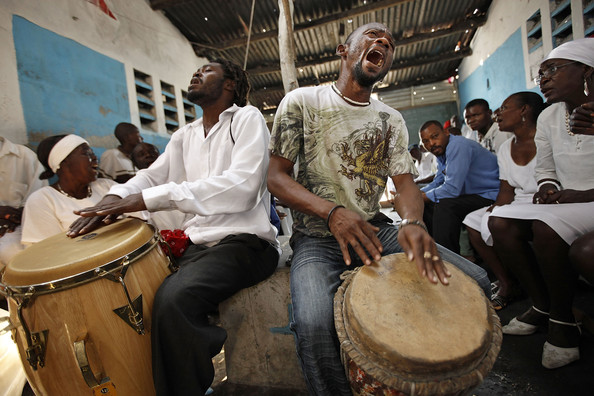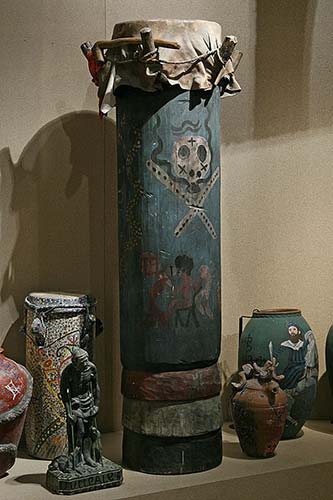Haitian Voodoo Drumming
Both historians and Haitian natives agree that voodoo, more correctly known as vodou, is an important and stigmatized religion that is distinctly and undisputedly Haitian in origin and affect. Some of its followers engage in it as an actual faith and others see it as more of a cultural exercise. One element of the practice that has intrigued and raised questions amongst listeners is the powerful musical leg, voodou drumming. Before exploring the music, though, one should first understand its origin.

What is Haitian Voodoo?
Vodou is not black magic, dolls with needles, or fire dances in the forest. It begins with thousands upon thousands of African slaves traveling to Haiti in the 17th and 18th centuries. These men and women, transported to a foreign place with a foreign purpose, were told to give up their beliefs and instead adopt a new foreign religion: Catholicism. Instead claiming apostasy, the slaves cleverly disguised their old deities within holy Catholic names. When questioned about their idols and practices, the accuser was told that the busts and representations were Africanized depictions of saints. This African and Catholic hybrid was something unique – and over time, was labeled its own religion, vodou.
Seven Nanchons
Practitioners of voodoo believe that there are spirits, called Loas (or Lwas outside of Haitian Creole) that are the guides and enablers in one’s life. Each spirit is an old soul who has individual powers and perks to grant to its followers. Through Haitian voodoo drumming, believers make themselves vulnerable enough that a Loa can enter the body of the drummer. This host “possessing” is deeply yearned by those who follow vodou. It is similar to being “filled with the Holy Spirit” in Christianity.
The Lwas belong to seven different nations, or “nanchons” in French. Each nanchon has its different customs, colors, and ways of operating. Also, each individual nanchon has its own kind of drum:

1. Rada, the strong “Balthazar”-type nation. The Loas of Rada are most respected and well-known in the Western world. Rada uses three families of drums: the Segon, the Boula, and the Manman, and one steel bell called the Ogan. The Segon is a mid-sized drum that creates a base rhythm on which the Manman dances. It is played by either one stick and one hand or two hands. The Boula is a small drum which plays the danceable rhythm that gives the Haitian voodoo drumming its soul. It creates a high and subdued tone that pops. The Manman is the backbone and time-setter of the ensemble. Whoever is leading the piece wields the Manman and creates a deep and hearty pulse.
2. Djouba, the farming and crop-bearing nanchon. Djouba often represents the common man and the everyday struggle.
3. Kongo, the nation from the Congo River. This nanchon is full of exciting song and dance; its outlook is often positive and the Lwas within it are often reminiscent of the African motherland.
4. Gède, the grim nation. The Loas of this nanchon are devoted to the cycle of life and death, and are often the ‘spooky’ ones that the media chooses to depict the entire vodou religion.
5. Nago, the powerful nation. Within Nago rests warriors, Nigerian leaders, and masculine energy.
6. Petwo, the fiery nanchon. Likely birthed right when the first Haitian slaves were arriving in their new permanent home, the Lwas of this nation are focus on speed, aggression, and forthrightness. The drums of the Petwo battery are much closer to thin congas than the distinct and more rounded instruments in Rada. This form of Haitian voodoo drumming has given way to Rada over the past several decades as the most traditional and popular form of the music within the religion.
7. Ibo, the prideful nation. From the Nigerian Ibo people, the spirits of this nanchon are often seen as a sub-derivate of others. They manifest themselves within the pots used at Haitian voodoo drumming ceremonies.
Haitian Voodoo Drumming Today
Though constantly battling with the widespread misrepresentation and stigmatized state of the word “vodou,” the vitality of the religion is still strong today. The musical elements present in Haitian voodou drumming have undeniably influenced genres like rara or Haitian rock. One can see performances in places where a Creole community is present, like throughout the Caribbean or within cultural hubs in other countries, like New Orleans, Louisiana or New York City, New York, U.S.A.
